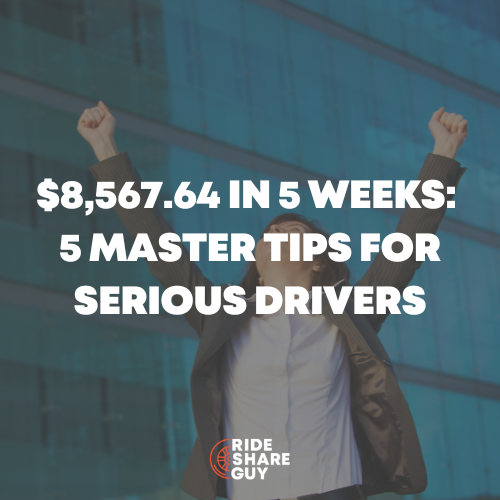Harry here. Most rides go off without a hitch, but with millions of trips per day, there are bound to be some unfortunate incidents. Today, RSG contributor John Ince recaps this week’s viral video and shares his tips on what to do if/when the situation gets out of hand AND how to avoid it in the first place.
A video went viral this week in which a passenger, who apparently requested a ride to the emergency room at a local hospital, refused to get out of the car, despite the fact that the app indicated that they had arrived at their destination. The female passenger wanted the male driver to take her to the entrance of the emergency room and he lost his cool in the face of her repeated insistence that he take her to what she considered her final destination. An altercation ensued and things escalated quickly as she recorded a video of the incident.
Drivers and most everyone else on message boards and Facebook sided with the driver who laced the passenger with such choice lines as “Get out of my f—ing car” and “I’m looking at a f—ing moron”. But if history is any guide here, the driver will likely be deactivated pending an investigation by Uber. In any event, the driver’s afternoon was ruined.
We’ve all faced similar situations though, and they always result in needless hours of lost sleep and questioning whether this job is really worth all the hassle. Take a look and see what you think (WARNING: Explicit language!)
In this situation, the driver was immediately in a compromised position because somebody in need of emergency treatment can be an object of sympathy, although there were ample comments questioning whether this particular passenger was truly in need of emergency care. It’s easy to see that Uber would err on the side of a passenger who at least on the surface can be seen as a person in special need.
Uber’s Reflex Response
Uber and Lyft have a longstanding and well documented policy of immediately deactivating drivers who are involved in altercations with passengers of almost any kind. One can certainly understand such a policy. Uber and Lyft must maintain a public stance that elevates passenger comfort and safety above all other considerations. Basically they want all rides to go smooth. If there are problems, the easiest way out is to boot the driver off the platform.
With hundreds of thousands of drivers, every single one of them – no matter how well they have performed over thousands of rides – is expendable. In other words, all drivers are commodities to Uber and Lyft.
You Can’t Win an Argument With A Passenger: This is the first and most important lesson that all drivers learn – both from personal experience and from spending any amount of time on driver message boards. Any escalation is viewed as a detriment to the driver, who – the reasoning goes – is lacking in interpersonal skills if they permit the situation to careen out of control.
But remember, driving is by its very nature a stressful occupation. Some drivers, responding to incentives put in place by the company, are logging upward of 60 hours a week, often navigating through extreme traffic conditions and putting up with all kinds of people in all kinds of moods and mental states. With Power Driver Bonuses (PDBs) that can give drivers up to $500 a week in bonuses alone, if they complete 120 rides in a week, drivers are often pushed beyond their limits. So Uber and Lyft create stress, because they want drivers on the road – until a driver reaches the breaking point – at which point they are summarily dismissed, or deactivated as the terminology goes in Uber-world.
The Emergency Aspect
This case is unique because drivers are often asked to perform a role for which they have no training or experience – like taking someone to an emergency room. EMTs/Paramedics must undergo extensive training before they’re allowed to transport people in such circumstances. But the cost of an ambulance can be several thousand dollars versus the cost of a Lyft or Uber, which in most cases is much less.
Increasingly, drivers are put in an awkward position – refuse someone in need or put yourself in a position that invites trouble. If you refuse, you risk the wrath and potential deactivation from Uber or Lyft. Accept and who knows what will happen. I’ve had three requests to the emergency room in two years of driving. All ended well, but for this unfortunate driver the situation did not.
The Case for Trespassing
The case illustrates another unsettled area of the law. For financial reasons, it’s advantageous for Uber and Lyft to classify drivers as independent contractors. Several lawsuits are currently pending over this issue. If a driver is an independent contractor, theoretically they have the right to ask a passenger to leave their car at any time. The car is the driver’s personal property and if a person refuses to leave when requested, one can make a good legal argument that they are trespassing on personal property.
But no driver wants the hassle of having to file a lawsuit and pay for all the expenses of something that probably won’t yield much more than a lot of lost time and money. So what is a driver to do if a person refuses to leave the car? You can do what this driver did and scream … and if the person still refuses … then what? Call 911, which this guy did? For the drivers, the upside is a few bucks in the fare. The downside, if any argument ensues, is deactivation or even a lawsuit.
Privacy Aspect
The case also illustrates the unsettled state of privacy law. Is it legal to record the incident? Was this passenger within her right to document what happened? Different states have different laws. But in general, most states make it a crime to record the audio of a conversation without the consent of all parties. Video is usually permissible. In this case, both audio and video were recorded, so the woman was likely breaking the law by recording the incident. But that’s small consolation to the driver, who basically just wants to get onto the next ride and certainly doesn’t want to have to bring a lawsuit to exert his rights.
This is just one more instance, where having a dash cam can provide the driver with evidence to support their case. Especially since the video conveniently leaves out whatever happened before the driver started screaming. For those interested in exploring this option check out this article: Epic Dashcam Review
Avoiding This Kind of Situation
So then the big question facing drivers is what can we do to avoid situations like this? The first thing to keep in mind is that once a passenger gets in the car, it’s very difficult to get them out. So it’s important to try to get a read on a passenger’s demeanor and state of mind at the earliest possible point. A phone call en route can serve this purpose. If the passenger seems stressed or starts complaining over the phone, a cancel may be in order. But as drivers all know, too many cancellations can get you in hot water with Uber and Lyft. High cancellation rates can even get you deactivated, so save your cancellations for when they matter.
Rule #1 – Don’t Start the Ride Until You’re Sure You Want This Person With You For The Trip
The next possible juncture to avoid these situations is immediately after the passenger gets in the car. Rule #1 for all drivers is don’t start the ride until you’re sure you want this person with you for the trip. Once the ride starts, the passenger has power over you in the form of the rating (passengers can only rate you if you physically slide to start the trip).
If they’re already in the car, and you have not yet started the ride, you can minimize the potential trouble by politely asking them to leave. That’s often easier said than done, and you’ve got to handle the situation delicately because it’s natural for anyone to take a request to leave as a personal insult. One time I had a pax request for about 2 AM at a bar in San Francisco. I was dead tired and she needed to go back into the Mission District, taking me in the opposite direction from my home. I said, something like, “I just came from there,” with evident displeasure. She jumped right on it and said, “That’s very rude.”
I knew at that instant that I didn’t want her and canceled. But now I had to get her out of the car? I was semi-honest with her. My real reason for not wanting the ride was that I didn’t want to risk a low rating, but I couched what I said in terms of safety saying, “I’m sorry I’m just too tired and don’t want to risk your safety.” She shot back, “But you accepted the ride.”
“Yes, that was a mistake,” I countered, “Now please leave my car.”
She then threatened to write Lyft and complain. I stood my ground and continued to emphasize the safety angle until she eventually left, but not before I had to raise my voice. By that point I was put out and didn’t get to sleep for several hours. When I finally got home, I replayed the incident over and over in my head.
Rule #2 – Choose the Course of Least Resistance
Rule #2 drivers for drivers is always choose the course of least resistance. In this video, this guy was obviously pissed at the woman for reasons that invite conjecture, but in retrospect it would have been much easier for all parties had he simply taken a few minutes more to find the emergency room entrance and take her there. Given that she was in some state of medical or emotional distress, the driver needed to factor that into his thinking.
Just last Saturday, I had a similar situation. It wasn’t at a hospital, but when we arrived at the destination, the woman sat there and asked me to drive up a very steep, unpaved driveway to let her out. I’ve had two previous cars whose transmission went out after going up hills like that one, so I put it to her plainly, “Can I ask you a favor?” I said, “This is an old car and I’d be totally screwed if the tranny went.” She got the point and said, “Sure, I can walk up.” Issue resolved.
The Bottom Line
The bottom line here is that we’re all human. If you’re honest with people and treat them with respect, you’re likely to get the same in return. With regards to Uber, I would hope that they might see this incident as an opportunity to curry favor with drivers and deviate from their traditional passenger-centric reflex response. Maybe this time, they’ll boot this woman off the platform and back up the driver here. Surely Uber is aware of driver disaffection, and this could be a great chance for them to show drivers some respect. But we’ll see, I’m not holding my breath on this one.
Drivers, what do you think about this incident and how would you have handled it? Have you ever had something similar happen? Please share in the comments below.
-John @ RSG
Save





